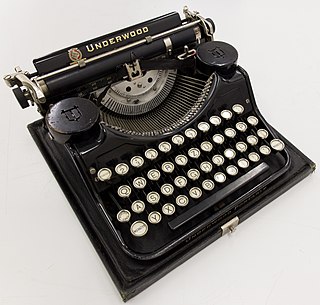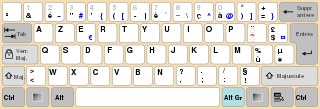The keyboard for IBM PC-compatible computers is standardized. However, during the more than 30 years of PC architecture being frequently updated, many keyboard layout variations have been developed.

QWERTY is a keyboard layout for Latin-script alphabets. The name comes from the order of the first six keys on the top letter row of the keyboard: QWERTY. The QWERTY design is based on a layout included in the Sholes and Glidden typewriter sold via E. Remington and Sons from 1874. QWERTY became popular with the success of the Remington No. 2 of 1878 and remains in ubiquitous use.

A typewriter is a mechanical or electromechanical machine for typing characters. Typically, a typewriter has an array of keys, and each one causes a different single character to be produced on paper by striking an inked ribbon selectively against the paper with a type element. Thereby, the machine produces a legible written document composed of ink and paper. By the end of the 19th century, a person who used such a device was also referred to as a typewriter.

Ø is a letter used in the Danish, Norwegian, Faroese, and Southern Sámi languages. It is mostly used as to represent the mid front rounded vowels, such as and, except for Southern Sámi where it is used as an diphthong.

The QWERTZ or QWERTZU, QWERTZUIOP keyboard is a typewriter and keyboard layout widely used in Central and Southeast Europe. The name comes from the first six letters at the top left of the keyboard:.

AZERTY is a specific layout for the characters of the Latin alphabet on typewriter keys and computer keyboards. The layout takes its name from the first six letters to appear on the first row of alphabetical keys; that is,. Similar to the QWERTZ layout, it is modelled on the English QWERTY layout. It is used in France and Belgium, although each of these countries has its own national variation on the layout. Luxembourg and Switzerland use the Swiss QWERTZ keyboard. Most residents of Quebec, the mainly French-speaking province of Canada, use a QWERTY keyboard that has been adapted to the French language such as the Multilingual Standard keyboard CAN/CSA Z243.200-92 which is stipulated by the government of Quebec and the Government of Canada.

IJ is a digraph of the letters i and j. Occurring in the Dutch language, it is sometimes considered a ligature, or a letter in itself. In most fonts that have a separate character for ij, the two composing parts are not connected but are separate glyphs, which are sometimes slightly kerned.

The Shift key⇧ Shift is a modifier key on a keyboard, used to type capital letters and other alternate "upper" characters. There are typically two Shift keys, on the left and right sides of the row below the home row. The Shift key's name originated from the typewriter, where one had to press and hold the button to shift up the case stamp to change to capital letters; the Shift key was first used in the Remington No. 2 Type-Writer of 1878; the No. 1 model was capital-only. On the US layout and similar keyboard layouts, characters that typically require the use of the Shift key include the parentheses, the question mark, the exclamation point, and the colon.

Caps Lock⇪ Caps Lock is a button on a computer keyboard that causes all letters of bicameral scripts to be generated in capital letters. It is a toggle key: each press reverses the previous action. Some keyboards also implement a light to give visual feedback about whether it is on or off. Exactly what Caps Lock does depends on the keyboard hardware, the operating system, the device driver, and the keyboard layout. Usually, the effect is limited to letter keys. Letters of non-bicameral scripts and non-letter characters are generated normally.
The numero sign or numero symbol, № (also represented as Nº, No̱, No. or no.), is a typographic abbreviation of the word number(s) indicating ordinal numeration, especially in names and titles. For example, using the numero sign, the written long-form of the address "Number 29 Acacia Road" is shortened to "№ 29 Acacia Rd", yet both forms are spoken long.

AltGr is a modifier key found on many computer keyboards. It is primarily used to type special characters and symbols that are not widely used in the territory where sold, such as foreign currency symbols, typographic marks and accented letters. On a typical Windows-compatible PC keyboard, the AltGr key, when present, takes the place of the right-hand Alt key. The key at this location will operate as AltGr if a keyboard layout using AltGr is chosen in the operating system, regardless of what is engraved on the key. In macOS, the Option key has functions similar to the AltGr key.

Backspace is the keyboard key that in typewriters originally pushed the carriage one position backwards, and in modern computer systems typically moves the display cursor one position backwards, deletes the character at that position, and shifts back any text after that position by one character.

In orthography and typography, a homoglyph is one of two or more graphemes, characters, or glyphs with shapes that appear identical or very similar but may have differing meaning. The designation is also applied to sequences of characters sharing these properties.

The Olivetti Lettera 22 is a portable mechanical typewriter designed by Marcello Nizzoli in 1949 or, according to the company's current owner Telecom Italia, 1950. This typewriter was very popular in Italy, receiving the Compasso d'Oro prize in 1954. In 1959 the Illinois Institute of Technology chose the Lettera 22 as the best designed product of the last 100 years.

A Hebrew keyboard comes in two different keyboard layouts. Most Hebrew keyboards are bilingual, with Latin characters, usually in a US Qwerty layout. Trilingual keyboard options also exist, with the third script being Arabic or Russian, due to the sizable Arabic- and Russian-speaking populations in Israel.
Olivetti is an Italian manufacturer of computers, tablets, smartphones, printers, calculators, and fax machines. It was founded as a typewriter manufacturer by Camillo Olivetti in 1908 in the Turin commune of Ivrea, Italy.

Dvorak is a keyboard layout for English patented in 1936 by August Dvorak and his brother-in-law, William Dealey, as a faster and more ergonomic alternative to the QWERTY layout. Dvorak proponents claim that it requires less finger motion and as a result reduces errors, increases typing speed, reduces repetitive strain injuries, or is simply more comfortable than QWERTY.

A keyboard layout is any specific physical, visual, or functional arrangement of the keys, legends, or key-meaning associations (respectively) of a computer keyboard, mobile phone, or other computer-controlled typographic keyboard.
The German keyboard layout is family of QWERTZ keyboard layouts commonly used in Austria and Germany. It is based on one defined in a former edition of the German standard DIN 2137–2. The current edition DIN 2137-1:2012-06 standardizes it as the first (basic) one of three layouts, calling it "T1".















